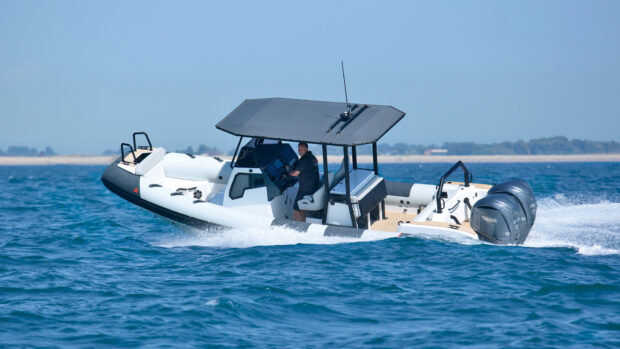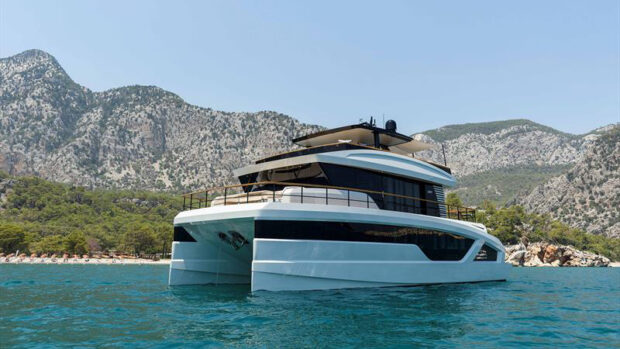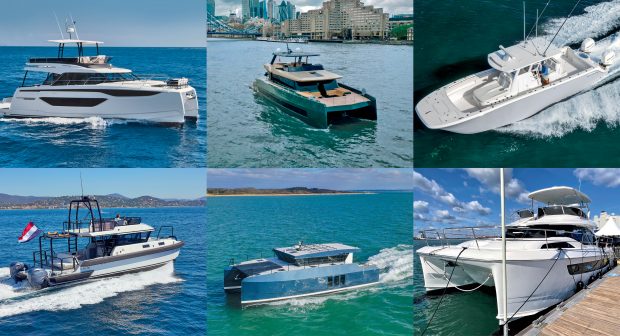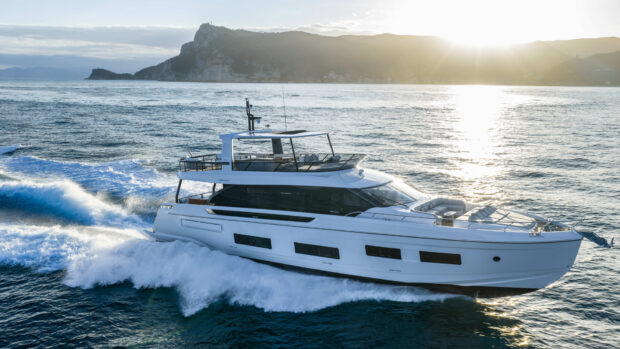Driving upwind into big seas, most planing boats need their bows pushed down to reduce pitching and slamming, that's where trim systems come in
Trim systems are devices, invariably electro-mechanical, which are attached to the transom. They help the skipper to control and optimise their boat’s running trim (attitude) and in some cases the real-time dynamic behaviour underway.
These systems vary immensely in their level of sophistication and control. Although these are not dedicated stabilising systems such as gyros and fin stabilisers, the most advanced trim systems are so powerful and fast acting that they are capable of providing a meaningful stabilising function, especially on small fast boats.
Why do all boats need trimming?
Never-ending change, that’s why. A strong crosswind will induce unwelcome heel; away from the breeze on a long-keel semi-displacement boat, and into the wind on a deep-vee planing boat. That heeling adversely affects visibility, steering and handling.

Interceptors are vertical blades which retract into their casing when not in use to sit flush with the bottom of the boat
Sea state typically has an even more discomforting effect on boat motions. Driving upwind into big head seas, most planing boats will benefit from having their bows pushed down to reduce pitching and slamming. In a beam sea, even the best designed boats can roll around, especially the big ’uns.
Finally, it is all but impossible to position all the tanks – fuel, water, black and grey waste – directly over the centre of gravity, so real time changes in tank levels will change the trim and therefore the behaviour of a boat underway. On a small boat, so will crew moving around the decks.
The weight and positioning of cruising stores and tenders can vary enormously. And pity the poor designer whose 10-metre RIB hull might have to cope with everything from a single 450hp outboard weighing 480kg to a pair of 380hp diesel sterndrives topping 1,520kg. So the notion that a perfectly designed boat might not need any help is a complete myth.

Humphree’s interceptors lower down vertically, trapping water in front of them. This acts as a wedge for the main flow of water, generating upward lift just like a trim tab
How do they work and what is their function?
There are two principal types: trim tabs and interceptors. Trim tabs comprise flat plates, arranged symmetrically port and starboard, that hinge along the front edge. Pushing either or both plates down into the water that flows aft from the transom creates a pressure build-up that pushes the plates, and hence the stern, upwards.
Interceptors generate the same pressure build-up, but use a flat blade that descends vertically into the water flow. That immersion generates a wedge of inert water in front of the blade, and that wedge mimics the effect of a conventional downward-angled trim tab plate.
Seakeeper’s new Ride system is something else. It employs rotary blades that swivel down to generate pressure on the fixed seal plates in front. It’s certainly different; however, in hydrodynamic and speed of operation terms it’s significantly closer to its interceptor siblings.
The aim of all of these systems is to control the degree of trim tab or interceptor immersion and hence the pressure build-up, and consequently to make the skipper and crew’s life better by managing unwelcome boat motions, in particular pitch and roll.

All boats are affected by wind, waves and loading but a good trimming system can dramatically reduce pitch, roll and yaw
Which boat motions can and can’t be controlled?
Beyond driving intelligently to suit the conditions, there is little anybody can do to control sway and surge. In theory, trim systems do not control heave or yaw directly. However, a boat which is running correctly and more unwaveringly because its trim system is reducing pitch and roll to a minimum will at the very least feel like it is heaving less. Yaw – that feeling of the bow wandering from side to side – will definitely be reduced.
That is because, when a boat rolls haphazardly over to one side, the underwater lines become asymmetric and that asymmetry introduces an unwelcome steering effect.
All planing boats will benefit enormously from a trim system, as will fast semi-displacement boats. Full displacement craft from the likes of Nordhavn do not go fast enough for interceptors or trim-tabs to generate consequential levels of lift.
With slower semi-displacement boats in mind, we asked eight trim system manufacturers at what speed could their systems begin to exhibit a meaningful effect, as opposed to a simply perceivable effect.
Article continues below…

Everything you need to know about sunburn and how to avoid it on the water

Everything you need to know about boat heating and air-conditioning
The answers varied considerably from 7 knots to 13 knots. Seakeeper’s answer thoughtfully separated the onset of simple trim assistance (about 9 knots) from the onset of the stabilisation (circa 17/22 knots) that its Ride system can provide.
Lenco said, “We see usable effectiveness beginning around 13 knots,” and that, “by about 16 knots an appropriately sized tab system should be considerably impactful.” Those latter speeds are the ones that really chime with our hands-on experiences. So our advice for owners of slow semi-displacement craft is to chat with the manufacturers to get assurances that their system can definitely provide a worthwhile trimming effect at typical cruising speeds.

Rough water causes the bow to pitch rapidly up and down.
What is the most basic system I can fit?
The most rudimentary system of all is a simple fixed affair which can either be angled plates akin to fixed trim tabs, or vertical plates equivalent to fixed interceptors. You would normally only fit these to a boat with an underlying condition that needed correcting.
For instance, a boat whose owner has fitted an abnormally heavy tender on the bathing platform, or a heavyweight aftermarket crane at the back of a flybridge, that was not in the original design brief. The idea would be to pre-emptively correct the stern-heavy running trim of the boat, regardless of whether an adjustable trim system is subsequently fitted or not.
Our advice here would be to fit interceptors near the centreline, leaving space for an adjustable trim system outboard, but also because fixed interceptor plates can be manufactured with elongated bolt holes that allow for adjustment to help get the running trim spot on.
Lenco and Bennett also make extremely simple trim tab systems for tenders and small boats which have spring-loaded rams. The plates are immersed at rest and generate lift at low speed to help them get on the plane but then automatically rise as the pressure builds up when the speed increases.

Trimming the bow down will help it to stay planted
What is the next step up?
An adjustable system with straightforward manual control of the interceptors or trim tabs. If you do stick with a manual system, think very hard about the physical controls, because you’ll be using them far more than you would on a system with full automatic control.
Some manufacturers use up/down rocker switches, others use dials or wheels, Bennett has a joystick option, and a few boatbuilders fit indicator-style stalks behind the wheel. Subjectively, we’ve always found the rotary controls from the likes of Lenco (Pro series) and Zipwake to be the quickest and most intuitive to operate, especially on small fast boats which react quickly to change.

Most modern automatic trim systems can also be linked to the boat’s MFD screen
Electric or hydraulic?
The electric ram versus hydraulic ram question is one you won’t need to ponder too deeply. The interceptor systems from Humphree and Zipwake and Volvo are fully electric, as is Seakeeper’s Ride. Almost all trim tabs sport electric rams.
So the only time you will encounter hydraulic rams is if you approach, say, Bennett, for an unusually high load trim tab setup suitable for a racing application, or possibly heavy commercial use. And in that case the manufacturer will steer you in the right direction.

This Zipwake controller uses a pair of rotary dials for both side to side and fore/aft trim
How do automatic systems work?
Automatic systems use a combination of sensors – gyroscope, GPS/compass, and accelerometers – to measure rates of turn, acceleration and movement. In combination, they can measure all six boat motions, and they typically log data at a frantic rate, up to 1,000hz.
This data can then be used, courtesy of a digital controller sporting adaptive algorithms, to control the interceptors or trim tabs directly. Consequently, auto systems can take over the task of micro-managing the two most impactive boat motions of pitch and roll, far more quickly and effectively than any human could.

Humphree’s automatic Lightning system can be upgraded in stages
Do auto systems undermine the skipper’s control?
Quite the opposite. There’s an initial setup routine for auto systems which varies from a simple ‘set to zero’ at rest for Seakeeper’s Ride, to the inputting of Length, Beam and Displacement for Zipwake’s system, to mapping the most efficient pitch curve for Lenco’s Pro Control. A flat calm day is essential, but none of these setup processes are difficult.
Once you’re underway in automatic mode, all these auto systems provide the skipper with the ability to fine tune the automatic programming. The first way is to adjust the system’s initial auto programming so that every time you go afloat, the system remembers exactly how you like your boat to run and trim.
This fine-tuning process varies, but it is not at all difficult, and can usually be carried out underway. The other technique is to tweak the controls on an as-needs basis to adjust the all-important pitch and roll to suit the prevailing conditions and the boat’s behaviour, for example bow down when heading upwind in choppy conditions.
These adjustment methods are complementary, not either/or choices, and in both cases the boat remains in auto mode, continuously controlling pitch and roll, but with your preferences overlaid on top.

This simple set of manual Bennett controls also shows the position of each trim tab
Trim tabs or interceptors?
Interceptor manufacturers are fond of claiming that their interceptors are more efficient than trim tabs, although in what capacity is invariably ambiguous. In practice it’s irrelevant because in their most sophisticated forms the advantages of both systems are so impactive and numerous.
The crucial difference is operational speed. Zipwake’s new Pro series 60mm stroke blades can go from fully up to fully down in 1.5 seconds, and Seakeeper claims that its rotary blades can perform up to 100 adjustments every second! In comparison, electric trim tabs would typically be around three to five times slower than an interceptor blade.
The smaller, lighter and faster the boat, the more it will benefit from this superior deployment speed, especially in automatic form. Smaller, lighter, faster boats react to fluctuating conditions more quickly and more noticeably, so the quicker the trim system reacts the better.
Plus, the extra interceptor speed means that, on small, fast boats in particular, a correctly sized automatic system can provide a meaningful stabilising function that the slower trim tab systems are unable to fully emulate with their auto-levelling.

A perfectly trimmed Riva Iseo running fast and flat
So are trim tabs past their sell-by date?
Absolutely not. Larger powerboats increasingly rely on gyros or fins for stabilisation, obviating the need for stabilising assistance from an interceptor trim system. If highly effective auto-levelling is all you need, then conventional trim tab systems are typically whole orders of magnitude cheaper than their interceptor siblings.
Using the Axopar 37XC Cross Cabin as a platform, we asked manufacturers for a price for their most sophisticated automatic trim system. Lenco’s trim tab 12 x 12 Pro Control Auto system was £2,636. At the other end of the scale Seakeeper’s fully automatic Ride 600 came in at £10,936 (both include 20% UK VAT).
Of course, the functionality and engineering of competing systems can differ enormously, so no comparison can ever be wholly like-for-like, but these figures do provide a useful pointer.
Finally, my hands-on testing suggests that interceptors are not the best choice for every single powerboat. Back in 2007, during back-to-back testing on a 44-foot Volvo IPS600-powered sportscruiser, I found that the boat was dynamically happier and slightly more stable when we switched the original interceptors for conventional trim tabs.
So it’s important to note that interceptor systems have in no way rendered their trim tab rivals redundant.

Mente Marine’s clever ACS controller
A special mention goes to…
Mente Marine. We wouldn’t normally single out a solitary supplier, but Mente Marine has a very singular product. It sells an ACS (Attitude Control System) control panel that links with other manufacturers’ trim tabs such as Bennett, Lenco, Eltrim and several others.
Despite its modest dimensions, the control panel contains all the necessary software and hardware (gyro, accelerometer, GPS/compass) to provide full automatic control of roll and pitch. Its big selling point is its price: assuming that a suitable set of trim tabs arrived with our Axopar 37XC Cross Cabin (or any other powerboat for that matter) Mente Marine would only relieve you of £648 (inc. UK VAT). It’s the cheapest way into automatic trim system ownership that we know of.

A top spec Humphree system is quick enough to provide stabilisation
What are the key benefits?
A correctly sized trim system will continuously correct for wind induced heel and for the movement of crew around the decks, but the list of benefits extends far beyond simply making life on board more comfortable by controlling and optimising the two principal evils of pitch and roll.
The frequently unsung benefits of a trim tab system is how it can contribute to safety on board. A correctly trimmed boat will produce less spray, improve the skipper’s forward visibility, increase crew comfort, reduce fatigue, minimise the potential for seasickness and reduce the chance of injury. At its most impactive, this can be life-saving stuff.
Handling also improves, as does performance – perhaps not significantly in calm conditions, but increasingly so as the weather deteriorates. During testing, we have found that it’s not uncommon to squeeze an extra 5% to 8% top speed from a boat by fine-tuning its trim, and that feeds directly into improved fuel consumption.
Remember too that a trim system can help a boat stay on the plane at much lower speeds; useful in speed restricted areas, not to mention for improving fuel economy.
It cannot be overstated just how much easier and more effective it is to achieve and maximise all these benefits with an automatic system, especially on a boat whose trim system settings have been optimised to suit the owner.
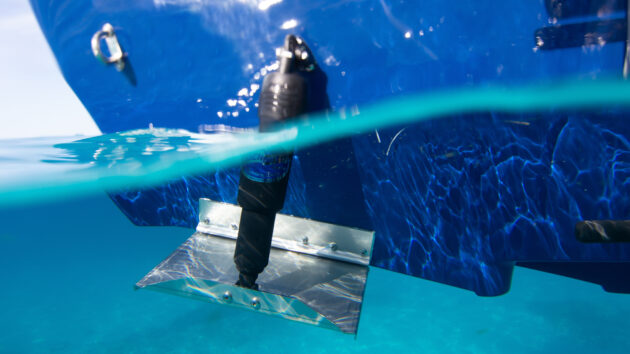
What more can automatic systems offer?
The functionality of automatic systems varies enormously, far too extensively to list here, but here are some of the collective functions available from the world’s pre-eminent manufacturers.
Acceleration or ‘hole-shot’. This trims the bow down and helps to propel you onto the plane as quickly as possible.
Deceleration. This maximises forward visibility should you ever need to bang the throttles into neutral, plus a separate ‘exit planing’ mode for the times you decelerate gently.
Auto-retract or full-up. This lifts them up to prevent damage when you’re reversing or beaching.
Co-ordinated turn. This trims the hull during turns, so your body is neither forced towards the outside of the bend, nor falls towards the inside of the turn. Think of it as a neutral-G turn which improves comfort and increases safety on board.

Trim tabs should be fitted with anodes to prevent electrolytic corrosion
Any other benefits?
RIBs and sportsboats are increasingly being fitted with extremely powerful engines. It’s easy for budding Max Verstappens to trim their engines out too far in the pursuit of maximum speed and suddenly find their boat chine riding or porpoising alarmingly. A fast automatic system should curtail these behaviours before they get out of hand.
A curious effect we’ve encountered, albeit inconsistent, is at very slow speeds on small boats, the sort you might expect to wander (yaw) a little. If you lower the trim tabs or interceptors fully, the directional stability sometimes improves slightly.
Zipwake’s dynamic trim control system incorporates a special steering mode. This is because interceptors can exhibit a useful steering effect. Having successfully piloted an XO360 most of the way through Poole Harbour using Zipwake’s user-friendly rotary control, I can vouch that it worked effectively enough to provide low-speed emergency steering. The corollary, which applies to all interceptors, is that this steering effect can sometimes be felt as unwelcome tugging on the wheel.

A non-copper based antifouling will help keep weed and barnacles at bay
Will a sterndrive or outboard conflict with a trim system?
Many modern boats now have systems that automatically adjust the trim of their outboard motors or sterndrive legs (for example Volvo’s Powertrim Assistant) usually by linking engine revs to leg trim. If your boat also has an auto trim system, our advice is to first programme the outboard motor or sterndrive leg in flat calm conditions with the boat loaded as close to its normal cruising condition as possible, and the auto trim system switched off.
After that, engage the auto trim system and if necessary and/or possible fine tune this to suit your requirements. Since the two systems do not talk to each other (in a digital sense) the trim system will simply ‘see’ a boat which is running more optimally as its starting point.
Note, you will almost certainly still have to trim the sterndrive leg or outboard motor out (up) going downwind in waves, to lift the bow. Trim systems can push the bow down, but once the interceptors/trim tabs are fully up, they don’t lift the bow any further.

Trim tabs are flat plates hinged at the leading edge which are pushed down into the water flow at an angle
Can a gyro stabiliser be used with fully automatic trim systems?
In short, yes. If your boat has both, our advice would be to experiment to determine the highest speed at which the effectiveness of the gyro alone is beginning to fade, and separately the lowest speed at which the effectiveness of the trim system alone is beginning to pick up.
Then examine how they work in conjunction throughout the speed range. Use that collective information to decide when, or if at all, to disengage the gyro (with its characteristically higher current drain) and rely on the trim system alone to deal with roll (lateral trim). Correctly sized interceptors or trim tabs will have the biggest effect on roll at planing speeds, so if you experience any strange effects with both systems engaged, try disengaging the gyro first.
Seakeeper, which also manufactures gyro stabilisers, confirmed that its Ride system can be used with a gyro. It also reports that, ‘the addition of a Seakeeper gyro stabiliser enhances the underway performance of Seakeeper Ride by an additional 10-20% from our tests.’
Does my trim system need antifouling or anodic protection?
Stainless steel trim tab plates do require anodes to protect them from electrolytic corrosion. Bennett warns owners NOT to ground the trim tabs to other underwater appendages. Don’t forget the usual anode selection criteria: zinc or aluminium for salt water; aluminium for brackish; and aluminium or magnesium for fresh water.
Interceptor blades and their housings are typically made from corrosion-free materials, and the composite materials do not cause the galvanic corrosion that would require them to have protective anodes. Normally, unless you have the luxury of a dry stack and a handy pressure washer, antifouling is recommended for interceptor casings and trim tabs (along with a base coat metal primer for the trim tabs). Make sure you leave a paint-free zone under the anode.

Seakeeper’s new Ride system can be retrofitted to most planing sportsboats
Do manufacturers recommend any other routine checks?
A regular gentle pressure wash is generally recommended by all. Seakeeper stresses that you should avoid the fierce turbo and rotating nozzles, and use a gentler 15-degree nozzle or more. Interceptor blades usually have a self-cleaning function that scrapes the blade clean when it is extended and retracted (ergo, do not antifoul these parts).
Zipwake recommends that if the boat has been in the water for a long time, to remove the front of the interceptors and pressure wash inside. However, Humphree lists an annual service routine that, over a period of ten years, includes calibration, replacing parts and seals, and re-torquing bolts, so interceptors are not entirely maintenance free.
As long as the correct anodes are fitted and regularly inspected (ideally ashore, but this can be done afloat) along with checking the hinges and the seals on the rams, stainless steel trim tabs should be relatively low maintenance.
Owners of Seakeeper’s Ride should refer to its online maintenance schedule, which sports the most wonderfully detailed and clearly illustrated instructions I’ve ever seen; it’s a benchmark destination for online help.
 If you enjoyed this….
If you enjoyed this….
Motor Boat & Yachting is the world’s leading magazine for Motoryacht enthusiasts. Every month we have inspirational adventures and practical features to help you realise your sailing dreams, as well as tests and news of all the latest motorboats.
Plus you’ll get our quarterly Custom Yachting supplement where we share the last on offer in the superyacht world and at the luxury end of the market.
Build your knowledge with a subscription delivered to your door. See our latest offers and save at least 30% off the cover price.
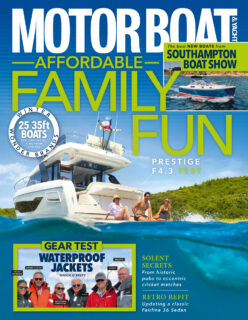


 If you enjoyed this….
If you enjoyed this….


